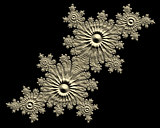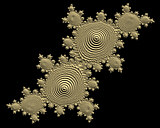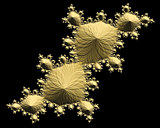The "Golden Mean" or "Golden Section" or "Golden Ratio", Phi, is a number that has
attracted more than its fair share of interest over time. Numerically, Phi is the
(positive) number that is equal to one more than its reciprocal: Phi = 1/Phi + 1.
Its little sibling is phi (lower case "p"); phi is the (positive) number that is
equal to one less than its reciprocal: phi = 1/phi - 1, about 0.618034.
While an irrational number, phi can be approximated by fractions such as 2/3, 5/8,
13/21, and 34/55. In fact, the fractions that best approximate phi (given certain
parameters) have numerators and denominators that are subsequent entries in the
Fibonacci series. That series starts out: 1, 1, 2, 3, 5, 8. Each element is the sum
of the 2 elements before it.
This series celebrates phi by presenting 9 Julia sets. The first 8 are associated
with the fractions 2/3, 3/5, 5/8, 8/13, 13/21, 21/34, 34/55, and 55/89, all "convergents"
to phi. The ninth image presents the same type of Julia set for phi. They are all
rendered using an embossing technique based on rose curves; the number of petals on
the rose curve is equal to the denominator of the fraction. Each of these Julia seeds
has a periodic orbit, the periodicity of which is also equal to the denominator of the
fraction. For the phi image, the sequence of periodic orbits deteriorates to chaos; the
seed has a chaotic orbit. Consequently, the rose curve would need an infinity of petals,
and the embossing curve is a circle. The images start out in grayscale, and move to a
golden tint, reflecting Phi's status as the "Golden Mean".

















